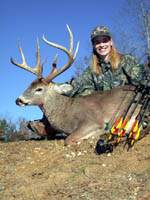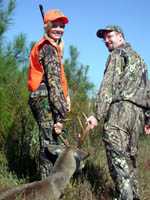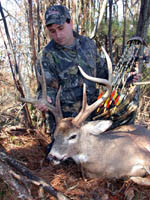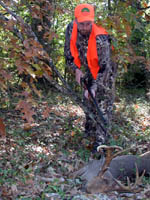
|
Features
|
|
|
|
Books
|
|
|
|
Fun & Games
|
|
|
|
Contact Us
|
|
|
John's Journal... Entry 218, Day 3
HOW TO TAKE HOT-WEATHER BUCKS
Cut The Grass To Attract A Buck
 Editor's
Note: Biologists know the old adage that bucks don't move in hot weather
isn't true. Bucks have to feed, bed and get water, regardless of the temperature.
Bucks just move very little in hot weather. As the world experiences global
warming, we'll have to learn to hunt for hot-weather bucks during bow
season. You can bag bucks with your bow in hot weather. The sportsmen
interviewed this week hunt primarily in the Deep South for at least three
or four months under hot-weather conditions each year and consistently
bag their bucks every season.
Editor's
Note: Biologists know the old adage that bucks don't move in hot weather
isn't true. Bucks have to feed, bed and get water, regardless of the temperature.
Bucks just move very little in hot weather. As the world experiences global
warming, we'll have to learn to hunt for hot-weather bucks during bow
season. You can bag bucks with your bow in hot weather. The sportsmen
interviewed this week hunt primarily in the Deep South for at least three
or four months under hot-weather conditions each year and consistently
bag their bucks every season.
Wesley Ashcraft of Birmingham, Alabama, hunted just outside of town on his aunt's small farm. A few years ago, Ashcraft noticed a deer trail that led from an old garden spot through Johnson grass back to a small creek. A 2-year-old clear-cut bordered a 30- to 40-yard stretch of hardwoods through which a small creek ran. Ashcraft had taken a stand in a tree halfway between the old garden and the creek bottom the year before during rifle season. He had seen bucks moving along the creek bottom but never could get a shot. The bucks never used the trail leading from the garden spot back to the creek bottom during daylight hours. The following summer, Ashcraft had an idea about how to bag a buck with his bow. He knew he needed to get the deer in close. He bush-hogged a 6-foot-wide path from the old garden spot past the tree where he placed his tree stand. A month before bow season, he noticed tracks along the path he had cut.
 Ashcraft
never had hunted deer with a bow until almost 10-years ago. But on opening
day of bow season with temperatures in the 90s, he left work early and
hurried to his aunt's farm. According to Ashcraft, "Just before dark I
saw a storm coming. The sky got gray, and I spotted a big thunderhead
in the distance. As the storm approached, I decided I shouldn't remain
in my tree until dark and get wet. I let my bow down. As I bent over to
pick up my bow, I looked through the bush and spotted a buck at the end
of the bush-hogged trail I had cut. I couldn't believe cutting the grass
and providing a trail for the bucks had worked." Ashcraft had practiced
with his bow and felt confident to take a shot to about 30 yards. He had
planned a tree-stand shot, not a shot from the ground. He hoped to take
a spike or a 4-point buck. However, the buck coming straight to him would
score 140 points on the Boone & Crockett scale.
Ashcraft
never had hunted deer with a bow until almost 10-years ago. But on opening
day of bow season with temperatures in the 90s, he left work early and
hurried to his aunt's farm. According to Ashcraft, "Just before dark I
saw a storm coming. The sky got gray, and I spotted a big thunderhead
in the distance. As the storm approached, I decided I shouldn't remain
in my tree until dark and get wet. I let my bow down. As I bent over to
pick up my bow, I looked through the bush and spotted a buck at the end
of the bush-hogged trail I had cut. I couldn't believe cutting the grass
and providing a trail for the bucks had worked." Ashcraft had practiced
with his bow and felt confident to take a shot to about 30 yards. He had
planned a tree-stand shot, not a shot from the ground. He hoped to take
a spike or a 4-point buck. However, the buck coming straight to him would
score 140 points on the Boone & Crockett scale.
 A
quartering wind blew from behind Ashcraft. As the buck approached, Ashcraft
knew he would have to make the shot at 30 yards or else the buck would
smell him. As the deer continued to close ground, Ashcraft began to doubt
his hunting ability. "I realized I only could have a head-on shot, and
I didn't want to make that shot," Ashcraft commented. "I knew if the buck
kept coming, he'd stand so close I couldn't miss him. But I thought I
had watched the buck for so long and had so long to think about the shot
that I'd still probably miss him. At least 100-different things went through
my mind as the deer headed my way." Preparing for the head-on shot, Ashcraft
drew his bow and began to raise up just over the cover. He had to move
some limbs out of the way to take the shot. When the buck came within
30 yards, fate dealt Ashcraft a winning hand. "The wind changed direction
and started blowing straight from behind the buck," Ashcraft reported.
"I knew he couldn't smell me because he kept coming straight toward me.
A
quartering wind blew from behind Ashcraft. As the buck approached, Ashcraft
knew he would have to make the shot at 30 yards or else the buck would
smell him. As the deer continued to close ground, Ashcraft began to doubt
his hunting ability. "I realized I only could have a head-on shot, and
I didn't want to make that shot," Ashcraft commented. "I knew if the buck
kept coming, he'd stand so close I couldn't miss him. But I thought I
had watched the buck for so long and had so long to think about the shot
that I'd still probably miss him. At least 100-different things went through
my mind as the deer headed my way." Preparing for the head-on shot, Ashcraft
drew his bow and began to raise up just over the cover. He had to move
some limbs out of the way to take the shot. When the buck came within
30 yards, fate dealt Ashcraft a winning hand. "The wind changed direction
and started blowing straight from behind the buck," Ashcraft reported.
"I knew he couldn't smell me because he kept coming straight toward me.
 When
at full draw and looking through his peepsight, Ashcraft suddenly couldn't
see the buck when a leaf fell between his peep and his pinsight. Although
he had to move a limb on the bush, his luck held. Just as he got a clear-sight
picture of the buck, only 15-yards away, the buck turned broadside. Then
the big buck presented Ashcraft with a dream shot as the buck quartered-away
and almost stood still when Ashcraft released the arrow. The buck jumped,
ran about 25 yards and then piled-up in a heap. Ashcraft took his trophy
of a lifetime on his very first bow hunt and utilized a strategy many
hot-weather hunters enjoy throughout the nation of cutting trails through
grass. Creatures of habit, deer prefer to take the path of the least resistance
when they move in thick cover during hot weather, many bowhunters have
learned they can cause deer to pass by their tree stands by cutting paths
through that thick cover for the deer to travel. You actually can funnel
deer into your tree stand by cutting trails the length or the breadth
of the cover. You can make deer leave one trail and walk your man-made
trail if your trail allows the deer to move through thick-cover areas
easier than the trail the deer already had established. In hot weather
when thick-cover regions have plenty of food, the deer don't have to come
out of the cover to feed. If you can make paths that allow the deer to
walk in thick cover easier, you'll often cause deer to come to you.
When
at full draw and looking through his peepsight, Ashcraft suddenly couldn't
see the buck when a leaf fell between his peep and his pinsight. Although
he had to move a limb on the bush, his luck held. Just as he got a clear-sight
picture of the buck, only 15-yards away, the buck turned broadside. Then
the big buck presented Ashcraft with a dream shot as the buck quartered-away
and almost stood still when Ashcraft released the arrow. The buck jumped,
ran about 25 yards and then piled-up in a heap. Ashcraft took his trophy
of a lifetime on his very first bow hunt and utilized a strategy many
hot-weather hunters enjoy throughout the nation of cutting trails through
grass. Creatures of habit, deer prefer to take the path of the least resistance
when they move in thick cover during hot weather, many bowhunters have
learned they can cause deer to pass by their tree stands by cutting paths
through that thick cover for the deer to travel. You actually can funnel
deer into your tree stand by cutting trails the length or the breadth
of the cover. You can make deer leave one trail and walk your man-made
trail if your trail allows the deer to move through thick-cover areas
easier than the trail the deer already had established. In hot weather
when thick-cover regions have plenty of food, the deer don't have to come
out of the cover to feed. If you can make paths that allow the deer to
walk in thick cover easier, you'll often cause deer to come to you.
TOMORROW: HUNT THE WATER
Check back each day this week for more about HOW TO TAKE HOT-WEATHER BUCKS ...
Day 1 - Hunt The Mast, The
Birds And The Squirrels
Day 2 - Salt, Mineral Licks And Pea Patches
Day 3 - Cut The Grass To Attract A Buck
Day 4 - Hunt The Water
Day 5 - Solve Hot-Weather Hunting Problems